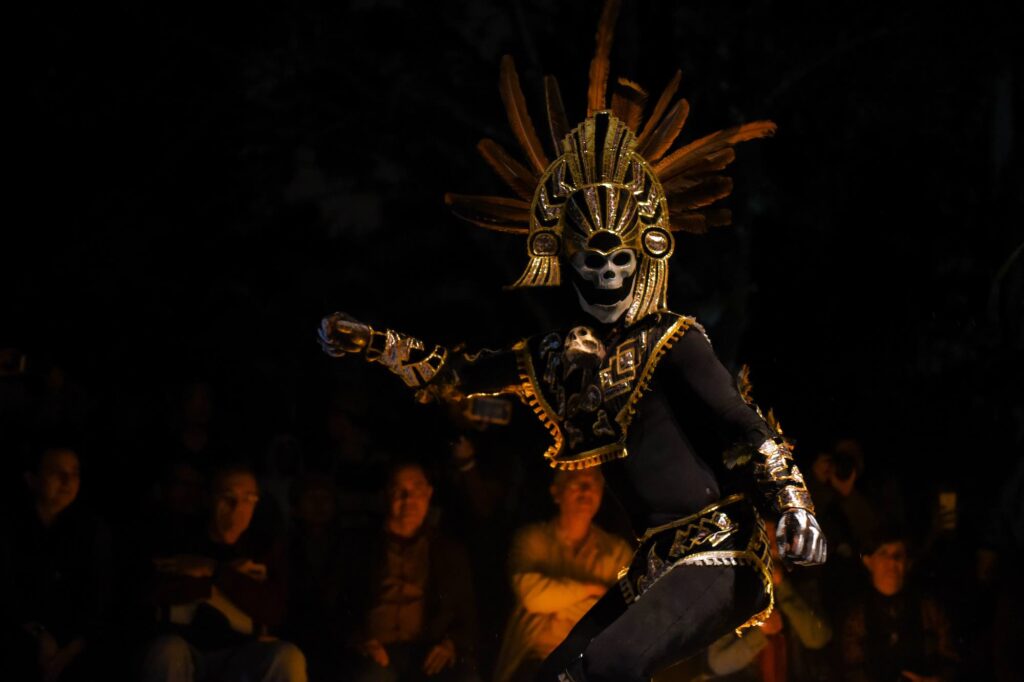
Rober Díaz. Península 360 Press [P360P].
A ciencia cierta, se sabe que son cuatro lugares que ocupaban la cosmogonía de los antiguos aztecas: La Casa del Sol en Teotihuacán; la Casa de las Mujeres Guerreras y del Dios Maíz: Cincalco; el Tlalocán o Paraíso del Dios del Agua, y el Mictlán o «lugar donde moran los muertos».
Estos puntos corresponden a los cuatro puntos cardinales pero, a diferencia de la visión occidental, existe un centro en sus tres planos cósmicos llamado Omeyocán donde reside la pareja creadora: Ometeólt, que corresponde al plano superior, en el centro de ese plano central se encuentra Huehuetéolt y, en el fondo de estos planos, el señor de los inframundos: Mictlantecuhtli y su reino que es el Mictlán o lugar de los muertos.
Este lugar es un lugar espacioso, sin ventanas de donde no se sale ni se puede volver, es el lugar de los dañados, la casa de la oscuridad: el Yoa ichán o casa de la noche, el Yoalli ichán región del misterio, el Ximoayán, donde están los descarnados.
Para entrar a ese sitio, había que atravesar distintos pesares que generalmente se situaban hacia el norte; sin embargo, se cree que pensaban que había igualmente cuatro entradas –en relación con los cuatro puntos cardinales y también había un quinto que se ubicaba al centro–: Tlaxicco, pero también fue común escuchar que esta entrada principal hacia la oscuridad estaba en el punto de occidente en la cueva de Cincalcoo Cicalco que, como antes mencionamos, era la entrada de las mujeres guerreras, el mismo rumbo por donde se ve desaparecer todas las tardes al sol y donde habita Tótec Chicahua y Huemán.
El camino para llegar hasta ahí era misterioso y lleno de penares, pero aquellos que morían estaban preparados, según Fray Bernardino de Sahagún se les mojaba la cabeza y se les enterraba con un jarro de agua pues deberían pasar por:
- En primer lugar, por dos sierras que están encontrándose una con la otra.
- Después, por un sitio donde está una culebra aguardándolos.
- Posteriormente, por donde se encuentra la lagartija verde llamada Xochitónal.
- Luego, por ocho páramos.
- Enseguida, por ocho collados (colinas).
- A continuación, por donde el viento frío corta como navajas.
- Más tarde, por el Río Chiconahuapán y cruzarlo en el lomo de un perro Xoloescuincle.
- Antes de terminar, por el lugar donde se presentan las ofrendas debidas a Mictlantecuhtli.
- Y luego de cuatro años, los nueve infiernos: Chicunaumictlán.
Los dioses que habitan los infiernos son como la mayoría de los dioses aztecas, una dualidad conformada por un dios masculino y uno femenino: Mictlantecuhtli y Mictecacíhuatl. Por los cronistas, se sabe que su cetro está hecho de objetos preciosos como huesos, cráneos y costillas y que, de ellos, se valió Quetzalcóatl cuando bajó al Mictlán para forjar el polvo con el que habría de formar a los seres humanos.
Como mensajeros tenían a los Yaotequihua –mensajero del Dios y la Diosa del Infierno–, que son los tecolotes y lechuzas las cuales si se presentaban en el lecho o a los alrededores de los enfermos y que era una señal inequívoca de que morirían.
Los Mictecas eran los agentes del inframundo, los cuales estaban encargados de evitar que aquel que pisara ese reino no pudiera salir. Además, existían seres inferiores dedicados a habitar los suburbios del inframundo que tenían diversas funciones que son mencionados y se presentaban como parejas en sus señoríos: el Ixputeque, quien tiene el pie roto; Nexoxóchitl, la que arroja flores; Nextepehua quien ciega con ceniza; Micapletacalli que es la caja del muerto; Tzontémoc que es aquel que cae de cabeza; Chalmecacíhuatlo la sacrificadora y Acolnahuácatl el de la región torcida.
Al Mictlán iban a parar todos aquellos que murieran de enfermedad, fueran príncipes, señores o macehuales, aquellos que no morían en la guerra, tampoco los que morían por medio de los sacrificios para los dioses, menos aún aquellas mujeres guerreras que morían al dar a luz –consideradas casi diosas–; tampoco iban los que morían ahogados o por algún evento relacionado con el agua o quemados por un rayo, al igual que los leprosos. No iban a dar ahí los que hubieran muerto por el fuego.
Pensaban que los caminos que tomaban las almas de los muertos no dependían de su comportamiento en vida, sino del tipo de muerte por el que habían pasado. El Mictlán, más que ser un castigo por el pecado, era una manera de purificación con la que las almas encontraban el descanso eterno, y uno donde no cabían diferencias sociales como en la Tierra.

